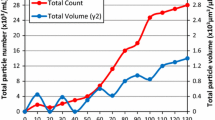Abstract
This study aimed at formulating simplified estimates of ion-activity products of calcium oxalate (APCaOx) and calcium phosphate (APCaP) in mouse urineto find the most important determinants in order to limit the analytical work-up. Literature data on mouse urine composition was used to determine the relative effect of each urine variable on the two ion-activity products. APCaOx and APCaP were calculated by iterative approximation with the EQUIL2 computerized program. The most important determinants for APCaOx were calcium, oxalate and citrate and for APCaP calcium, phosphate, citrate, magnesium and pH. Urine concentrations of the variables were used. A simplified estimate of APCaOx (AP(CaOx)-indexMOUSE) that numerically approximately corresponded to 108 × APCaOx was given the following expression:
For a series of urine samples with various composition the coefficient of correlation between AP(CaOx)-indexMOUSE and 108 × APCaOx was 0.99 (p = 0.00000). A similar estimate of APCaP (AP(CaP)-indexMOUSE) was formulated so that it approximately would correspond numerically to 1014 × APCaP taking the following form:
For a series of variations in urine composition the coefficient of correlation was 0.95 (p = 0.00000). The two approximate estimates shown in this article are simplified expressions of APCaOx and APCaP. The intention of these theoretical calculations was not to get methods for accurate information on the saturation levels in urine, but to have mathematical tools useful for rough conclusions on the outcome of different experimental situations in mice. It needs to be emphasized that the accuracy will be negatively influenced if urine variables not included in the formulas differ very much from basic concentrations.





Similar content being viewed by others
References
Tiselius HG (1984) A simplified estimate of the ion-activity product of calcium phosphate in urine. Eur Urol 10:191–194
Robertson WG (1969) Measurement of ionized calcium in biological fluids. Clin Chim Acta 24:149–157
Werness PG, Brown CM, Smith LH, Finlayson B (1985) EQUIL2: a basic computer program for calculation of urinary saturation. J Urol 134:1242–1244
Ashby R, Györy AZ (1997) Thermodynamic equilibrium model for calcium salt urolithiasis: clinical application. Exp Nephrol 5:246–252
Rodgers AL, Allie-Hamdulay S, Jackson G, Tiselius HG (2011) Simulating calcium salt precipitation in the nephron using chemical speciation. Urol Res e-publication 39:245–251
Tiselius H-G (1982) An improved method for then routine biochemical evaluation of patients with recurrent calcium oxalate stone disease. Clin Chim Acta 122:409–418
Tiselius H-G (1989) Standardized estimate of the ion-activity product of calcium oxalate in from renal stone formers. Eur Urol 16:48–50
Tiselius H-G (1991) Aspects on estimation of the risk of calcium oxalate crystallization in urine. Urol Int 47:255–259
Tiselius H-G, Ferraz RR, Heilberg IP (2003) An approximate estimate of the ion-activity product of calcium oxalate in rat urine. Urol Res 31:410–413
Khan SR, Glenton PA (2008) Calcium oxalate crystal deposition in kidneys of hypercalciuric mice with disrupted typ IIa sodium-phosphate cotransporter. Am J Physiol Renal Physiol 294:F1109–F1115
Khan SR, Glenton PA (2010) Experimental induction of calcium oxalate nephrolithiasis in mice. J Urol 184:1189–1196
Salido EC, Xiao ML, Yang L, Xia W, Santana A, Roy-Chowdhury N, Torres A, Shapiro LJ, Roy-Chowdry J (2006) Alanine-glyoxylate aminotransferase-deficient mice, a model for primary hyperoxaluria that responds to adenoviral gene transfer. PNAS 103:18249–18254
Grujic D, Salido EC, Shenoy BC, Langman CB, McGrath ME, Patel RJ, Rashid A, Mandpati S, Jung CW, Margolin AL (2009) Hyperoxaluria is reduced and nephrocalcinosis prevented with an oxalate-degradingt enzyme in mice with hyperoxaluria. Am J Nephrol 29:86–93
Author information
Authors and Affiliations
Corresponding author
Rights and permissions
About this article
Cite this article
Tiselius, HG., Ferraz, R.R.N. & Heilberg, I.P. Simplified estimates of ion-activity products of calcium oxalate and calcium phosphate in mouse urine. Urol Res 40, 285–291 (2012). https://doi.org/10.1007/s00240-011-0443-1
Received:
Accepted:
Published:
Issue Date:
DOI: https://doi.org/10.1007/s00240-011-0443-1




